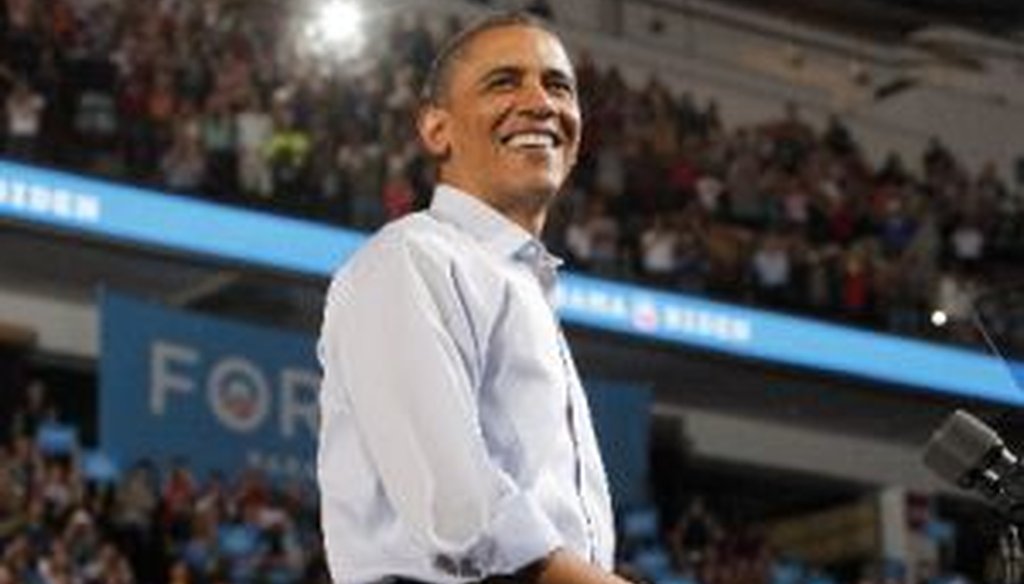

Our only agenda is to publish the truth so you can be an informed participant in democracy.
We need your help.


President Barack Obama speaks during a campaign rally at the Value City Arena in Columbus, Ohio, on May 5, 2012.
President Barack Obama has repeatedly argued that his Republican rival Mitt Romney is pursuing policies that favor the rich. Recently, Obama offered a specific claim about how wealthier Americans would benefit from Romney’s tax plan.
In a May 5, 2012, campaign speech in Columbus, Ohio, Obama said, "My opponent won’t tell us how he’d pay for his new, $5 trillion tax cut -- a tax cut that gives an average of $250,000 to every millionaire in this country."
We wondered whether Romney’s tax proposal really would be so generous to millionaires. (The Romney campaign didn't respond to our inquiry for this story.)
First, some background on what Romney is proposing. Here are some of key elements of his plan, according to the campaign’s website.
For individuals:
• Cut marginal rates by one-fifth on a permanent, across-the-board basis
• Eliminate interest, dividend, and capital gains taxes for taxpayers with an adjusted gross income below $200,000
• Eliminate the estate tax
• Repeal the Alternative Minimum Tax
For corporations:
• Cut the corporate rate to 25 percent
• Make permanent the research and development tax credit
• Switch to a territorial tax system
• Repeal the corporate Alternative Minimum Tax
The Romney campaign's website states that lowering both individual and corporate tax rates will stimulate economic growth. High tax rates "discourage work and entrepreneurship, as well as savings and investment," the website states. "With 54 percent of private sector workers employed outside of corporations, individual rates also define the incentives for job-creating businesses. Lower marginal tax rates secure for all Americans the economic gains from tax reform."
And in a speech on March 30, 2012, Romney affirmed his plan to cut taxes for everyone: "Taxes should be as low as possible, in line with those of competing nations, and designed to foster innovation and growth. That's why I will cut marginal tax rates across the board. "
For an independent assessment of Romney’s plan, we turned to the Urban Institute-Brookings Institution Tax Policy Center, a think tank that, among other things, evaluates the tax proposals submitted by presidential candidates. While judging tax proposals is subject to some degree of interpretation, the Tax Policy Center has a significant degree of respect in tax circles.
The Tax Policy Center looked at two versions of Romney’s tax proposal. We will use the analysis of the more recent of Romney’s two plans, which the group published in March 2012.
Before we look at the center’s analysis, we should note that the group ran two sets of numbers. One version, known as "current law," essentially gives Romney credit for extending the tax cuts enacted under President George W. Bush and for an annual adjustment in the Alternative Minimum Tax. Under this calculation, taxpayers’ savings from these two extensions are added to the total tax cuts from Romney’s tax proposal itself.
The other version, known as "current policy," assumes that the Bush and AMT tax cuts will be extended, with or without Romney. This method only counts the taxpayer savings from the new proposals in Romney’s tax plan -- a smaller amount of tax savings than Romney would see under the "current law" calculation.
It turns out that the "current policy" calculation is the one that backs up Obama’s claim. The Tax Policy Center found that under Romney’s proposal, people with $1 million or more in annual cash income will receive an average tax cut of $250,535. Those in the millionaire category will receive an 11.8 percent increase in after-tax income, easily the highest of any income group. Collectively, the tax savings for millionaires would amount to nearly one-third of all the tax benefits that result from Romney’s plan.
The "current law" analysis shows even bigger gains for millionaires. By this method, the average tax cut for someone with cash income north of $1 million a year would be $390,876, according to the Tax Policy Center.
And the higher you go on the income scale, the bigger the tax cuts become. Under the center’s more restrictive "current policy" method, the top one-tenth of 1 percent of taxpayers -- those earning $2,868,534 a year -- would get an average tax cut of $725,716. That accounts for 19.4 percent of all the tax cuts’ benefits.
Our ruling
Even using the more restrictive of the Tax Policy Center’s two calculations, Romney’s tax plan would save millionaires almost exactly what Obama said -- $250,535. We rate the statement True.
Barack Obama, speech at Value-City Schottenstein Center Columbus, Ohio, May 5, 2012
Mitt Romney for President, "Tax: Fairer, Flatter and Simpler," accessed May 7, 2012
Tax Policy Center, "The Romney Plan (Updated)," March 1, 2012
Email interview with Joseph Rosenberg, research associate for the Urban Institute-Brookings Institution Tax Policy Center, May 7, 2012
In a world of wild talk and fake news, help us stand up for the facts.
